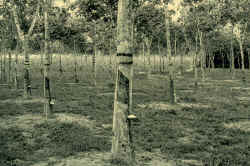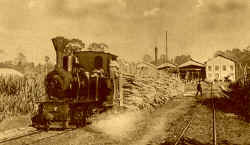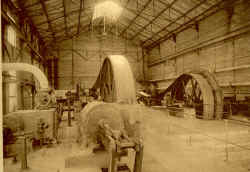

The epopee of rubber, by George Boilerman, the Great Investigation of the Colonial Dispatch, 1927, Library Stock (Boilerman took part in Yellow Cruising in 1932)
| This is an "enhanced" translation of the Google translation of the the original pages of the "The epopee of rubber!" published by François Denis FIEVEZ. It appears here with his kind permission. The translation from English to French is not his work and he is not responsible for any errors that you might find, but of Google and myself. You are invited to visit Fracois' site at http://belleindochine.free.fr/Caoutchouc.htm if you read French or you might want to visit the French to English Translation at this Google Link if not. jwavra, webmaster |
The epopee of
rubber!
Indo-China produced 10 million metric tons of latex in 1931; It produced 130 million in 1995, and still a little today.
The Trade union of the growers counted 139 growers among many companies.
The hospital of the Michelin plantation
Hévéa in Indo-China
“In 1897, Raoul, a pharmacist, on a mission in Java, brought seeds of Hévéa to the botanical garden of Saigon for the first time in 1891, and tested it without result.
The seedlings were placed partly with the experimental plots of the Ongiem Agricultural Services and the remainder with some of the colonists. At the same time (1898-1899, Mr. Belland established, the first small plantation of hévéa, by his own means, around Saigon. However, it took eight years before this incipient culture took consistency, that in spite of enthusiastic efforts of Capus, directing Général of the Economic Services, of Josseline, Seligman, of Doctor Yersin, Canavaggio, O'Connel, Guèry and finally Cazeau, Girard and Haffner.
Drier with rubber (Maspéro, 1929)
The creation of the plantations of Suzannah (1907) and Xatrach (1908) took until 1918 requiring large blocks of rich grounds and a large company with rational methods and suitable capital.
It is here in the raised areas in the hilly and timbered North that the effort was dedicated. There, two types of soil, called according to their color meet: gray soil and red soil, both being appropriate for Hévéa. The red soils, with strong powerful retention of water and their total wealth in phosphoric acid and iron, make this red soil much richer than the gray ones. The hévéa prospered admirably; however, only their distance, their thick vegetation (forest of bamboo), the absence of on the spot labor make their exploitation difficult and requires important capital.
In 1911 there were 4,900 hectares of plantations. Growth was remarkable up to the war (WW I). The fall of rubber prices in 1920, 21, 22 stopped further planting and finally the abandonment of many of the small plantations. The remainder was rebalanced in 1923 when rubber prices strongly went up in 1925 until 1928… With this date, the resulting production was 10,330 tons on 9,.225 hectares, including 60% resulting from the red soils. On this date, the Dutch West Indies produced 108,000 tons…
In 1928, the plantations of Indo-China used the services of more than 80.000 indigenous workers , more than half recruited for work in Tonkin (Vietnam)."
Payment of the latex (Maspèro, 1929)
"The factories of metropolis use 68,000 tons, but hardly 5,483 tons comes from Indo-China…
A large effort of colonization was provided for rubber in Cochinchine, which had in major part with energy and tenacity of the growers. The administration, it as, well fulfilled its role, not only by the effective assistance as it gave them, but while contributing, it even with research on the hévéas, the latex, rubber, etc…
It is a pride for the French of Cochinchine to have these large rubber plantations, which can support the comparison with those of the Dutch West Indies or the Malayan Peninsula, by size and the results obtained."
According to Modern Indo-China, Percheron and Teston, 1931
 |
Production
The Asian countries represented 94% of the production in 1995 , Africa 4.4% and South America 1,3%
Today, the hévéa culture provides work for 8% of the population of Thailand, that is to say 5 million inhabitants!
Over the last years, the increase in the production in the Indochinese peninsula is very spectacular:
In Kampuchea, the trees suffered from an irrational and irregular overexploitation. Nevertheless the quality of the grounds is real and exports passed from 25 thousand tons metric in 1987 to 44 in 1995. A free-Kampuchean protocol was signed for the rehabilitation of the hévéa culture.
Vietnam benefited from the assistance of the USSR in years 1975 to 89 and increased considerably her cultivated surfaces: from 55 to 95 miles metric tons from 1987 to 1995.
According to “the Natural rubber”, Economica, 1997
|
|
Company of the plantations of An Loc - Panorama of the industrial center - red Grounds. Access by rail. Creation in 1910. 171 committed coolies and 632 free coolies. Production (1928): 375 tons. |
 |
Plantations of Dian
(Bo-Muà Section).
House of the chief of Export Within 76Km of Saigon; Setting in production in 1928. |
 |
Company of the
Plantations of Dian - Drainer - Departure of the sheets towards the
smoking-room
Drier |
Harvest (industrial)
Between 5 to 6 a.m., the harvester collects latex and then carries it tothe collecting center. The latex is placed in buckets and then a cistern and is stabilized with ammonia to avoid any coagulation. In factory, coagulation is obtained by the addition of formic acid to the latex. On the outlet side of the coagulation vat, rubber is generally treated with the rolling mill; equipped with smooth-wheel or grooved rollers. Drying during several hours intervenes then, generally makes some by maturing in buildings for this purpose. The rubber sheets are then compressed into balls of 250 pounds (113 kilos).
 |
Agricultural and Industrial company of Bencui - Village of contractual coolies |
 |
House of the Director General of the Plantations - Company of the Plantations of Dian |
 |
 |
Companies of Hévéas de Tay Ninh - Interior of the factory |
Use of the natural rubber
By its properties of elasticity, resistance to wear and to heat, the natural rubber is essential in many fields such as aeronautics, mechanics, the medical field, adhesives etc. However, rubber for making tires accounts for 70% of the use of the natural rubber in the world.
Synthetic rubber
Synthetic rubber was born in Germany in 1909. It made it possible to circumvent the successive blockades during WW II and whereas the sources of providing rubber were cut by Japan. The USA built in 3 years an industry of the synthetic rubber, containing oil and alcohol, which then met their needs. After the war, gradually all the developed countries started to produce synthetic rubber, thus making natural rubber less important. In 1963 synthetic rubber consumption overrode that of natural rubber in terms of tonnage.
However, natural rubber yielded a larger share of the market, because of the joining of the tire with radial metal carcass invented in 1948 by Michelin and for which the natural rubber is better suited. In the same way, the rise of oil made synthetic rubber more expensive. Today, natural rubber accounts for 39% of the overall consumption, after 31% in 1970.
 |
 |
Plantation F.Canque has Chanh-Lim - Interior of a housing of farm laborer and reception of latex to the factory after the bleeding. |
The hévéa culture
The culture of the hévéa Brasilensis is particularly well adapted to a temperature of 25 ° Celsius and high amounts of rainfall of 1800 to 2500 mm per annum. The favorable zones are thus inside the equatorial and tropical zones. That is the case of Indonesia and Malaysia. The climates of monsoon as in Thailand, to Vietnam and for Kampuchea, in India (Kerala) are appropriate as well.
The hévéa, with a height of approximately 20 meters, produces latex through its bark. To obtain latex, the harvester using a knife or of a gouge, opens the tender bark generally in a spiral. The wound quickly lets beads of the latex drops appear which run out along the notch of the bleeding. Hévéa can thus “produce” several days per week, almost all year for more than 30 years.
It takes 8 years between the planting of a hévéa and the first latex collection.
 |
 |
Plantation of Chanh-Luu - Dwelling house and Factory |
Life in a plantation in Indo-China (according to “the Epopee of Rubber”, 1927)
“The growers lunched at Berquel. They were directors of plantations. They were sent in Indo-China by their company, as the generals are sent on the field of the operations by their government.
But they fight for the same cause.
They were not apparent competitors. Results were exchanged. One discussed the courses of rubber, the cost prices and the wages.
These men represented 30,000 hectares of concessions which would be of great value in a few years. They had gained these 30,000 hectares on the bush in less than 20 years. One could admire these achievements.
- When will you marry Berquel?
- Me? When I go back to Angers, in 2 years.
- You should explain to our young people in France that one should not embark for the 1st time to Indo-China with a woman in his luggage. The husband has to work 10 hours per day. The woman does not have anything to occupy her and is bored. The best spares do not resist it. And then the wages at the beginning make it difficult to live at first. If a child arrives, it is an embarrassment. Therefore, there are no children.
- How much do you pay your coolies, Jannsen?
- Always forty hundreds, plus rice.
Belin discussed with Ferraut the question housing the indigénes (natives). It claimed that the Tonkinois or Annamite prefers an individual box. It was in favor of the village and pushed back the hutments….
 |
 |
Michelin plantation -
Hospital Room of the bandages.
Orphanage - the meal of the children. |
 |
 |
Michelin plantations - Sawmill - old and modern Transport |
 |
 |
Company of Rubbers of Indo-China (Loc Ninh) Village (left); houses of coolies (right) |
 |
 |
Michelin plantation; Laboratory/Factory for test for treatment of gums. Instrument room. |
 |
Plantation of Phu-Thu - Dwelling house |
 |
 |
Plantations of the
Red Grounds, plantation of Quan Loi Room of Coagulation |
 |
Plantations of the red grounds, plantation of Xatrach - Coagulation of Latex. |
According to “the Epopee of Rubber”, 1927:
“- You will return to France, to speak with the public about rubber, the plantations, the colonial life. Young people will read you. Let me tell you my thoughts a little. To have the faith. This word is my program. Do not think that I quote my life in example. I am, me, only one amateur. I have here only one ambition and that is to be buried here in a place which I like. I already chose it. Exoticism is my tried step. I do not smoke opium, I do not drink alcohol, I do not have a congaye (mistriss). I like the simple and hard life. One can want to earn money and to keep the faith… These two requirements are not incompatible. If I had a son.
His voice trembled a little.
- If I had a son, he began again, I believe that I would have known to make him like my stock. A creation containing love. A true grower likes his ground. Any creation contains love. A true grower likes his ground, his trees, his indigenous coolies. However, to like the indigéne (natives), it should be included/understood. And to include/understand them, their language should be spoken. “
 |
Plantations of the Red Grounds, plantation of Xacam - Seedbeds of Héveas. |
 |
Kerhuella plantations - 2nd seed garden of elite of Java - May 1929 |
 |
Plantation of Dian: clearing |
 |
Well Hoa Industrial
and Forest Cay Gao - Camping of K 20 (déc 1929)
57Km from Saigon; gray ground; local labour of 10-12 coolies |
 |
 |
Civil company of the Plantations of Tan Phong; Transport of the structural timber; Saw mechanical |
 |
 |
Plantations of Dian: cane with 8 month old sugar |
 |
 |
Agricultural and Industrial Camwood Tiem company - Interior of the power station - Transport of sugar canes towards the factory |
 |
Map of the plantations of Cochinchine, about 1931. In green, plantations of Hévéas
|
If you seek data or photographs on a plantation, do not hesitate to contact me: the Directory of the Growers comprise indeed many photographs not presented here.
Original French Site Translated by Google
Original French Site